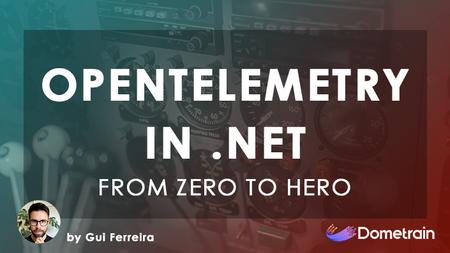English | MP4 | AVC 1920×1080 | AAC 44KHz 2ch | 71 Lessons (4h 22m) | 911 MB
Learn what OpenTelemetry is and why your apps need it
OpenTelemetry offers a unified, open-source standard and a suite of technologies for capturing and exporting metrics, traces, and logs from your cloud-native applications and infrastructure. It is not a .NET-specific technology but a universal one that every application should follow. Modern applications are distributed, and capturing and exporting telemetry data can be challenging. With OpenTelemetry’s standardized approach and technological tools, capturing data and exporting it to participating technology vendors or open-source projects becomes simpler. This course will equip you with the knowledge and skills to integrate OpenTelemetry into your systems. Gui will explain why OpenTelemetry is necessary for every modern .NET application, and by the end of the course, you will be ready to implement it and use it effectively.
Table of Contents
1 Welcome
2 What will you learn in this course
3 Who is the course for and prerequisites
4 What is Observability
5 What is OpenTelemetry
6 Traces, Metrics and Logs
7 Context and Correlation
8 Section Recap
9 Demo Architecture
10 Demo Preview
11 Introduction
12 Adding Automatic Instrumentation
13 Introduction (2)
14 NET Terminology
15 What is a Resource
16 Adding Instrumentation
17 What are Instrumentation Libraries
18 Using Instrumentation Libraries
19 Section Recap (2)
20 Introduction (3)
21 What is a Trace
22 Adding Tracing
23 Exporting to Jaeger
24 Adding Additional Context
25 Section Recap (3)
26 Introduction (4)
27 What is a Metric
28 The Instrument Types
29 Adding Metrics
30 Exporting to Prometheus
31 Using .NET Meters
32 Visualising Metrics on Grafana
33 Section Recap (4)
34 Introduction (5)
35 The Protocol
36 What is the Collector
37 Architecture with a Collector
38 Running the Collector
39 Receivers
40 Exporters
41 Exporting to the OTLP collector
42 Processors
43 Section Recap (5)
44 Introduction (6)
45 What is a Log
46 Why use Logs for Observability
47 Adding Logging
48 Exporting to Loki
49 Enriching Logs
50 Section Recap (6)
51 Introduction (7)
52 What is Baggage
53 Adding Baggage
54 Creating a Context Propagator
55 Propagation risks
56 Section Recap (7)
57 Introduction (8)
58 Creating a Span Processor
59 Manually creating Spans
60 Creating Span Events
61 Representing Errors and Exceptions
62 Creating Span Links
63 Section Recap (8)
64 Introduction (9)
65 What is Sampling
66 Head Sampling
67 How to create a Sampler
68 Tail-based Sampling
69 Configuring Tail-based Sampling
70 Section Recap (9)
71 Conclusion
Resolve the captcha to access the links!
